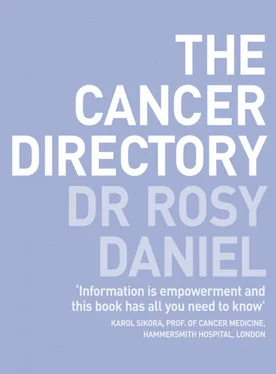• anti-cancer nutrients that are taken by mouth to help combat cancer directly or to stimulate the body’s immune and tissue-healing systems
• herbal medicines that are believed to have direct anti-cancer properties or indirectly inhibit cancer growth
• intravenous metabolic cancer therapies that provide high-dose nutrients or herbal extracts for the body designed to exert a cytotoxic (cancer cell-killing) anti-cancer effect
• immunotherapy aimed at repairing or boosting immune function to get the body fighting cancer naturally
• neuroendocrine therapies aimed at rebalancing the body’s hormones and neurotransmitters to inhibit cancer growth
• physical therapies in which heat, light or oxygen is used to treat cancer
• nutritional therapies where strict diets are used to combat cancer
• mind – body medicine, where mind – body approaches are used to restore immune function and direct tissue-healing.
3. Complementary supportive care
Complementary cancer medicine involves the use of natural medicines or therapies that can be used in a supportive context alongside orthodox treatment for physical, emotional and energy support. These are written about in detail in Chapter 7; their role in symptom control is covered in Chapter 8. These are usually accessed in the community from complementary therapists practising in complementary therapy centres or from their homes, but are becoming increasingly available in hospitals and hospices (from nurses or complementary therapists). These include:
• touch therapies such as massage, aromatherapy, osteopathy, craniosacral therapy, shiatsu, acupressure and reflexology
• energy therapies such as acupuncture, reiki healing, spiritual healing and Johrei
• natural remedies such as herbal medicines, including European, Chinese and Indian Ayurvedic herbs, and homoeopathic remedies
• mind – body symptom control through hypnotherapy, visualization, relaxation, guided imagery and affirmation
• nutritional and immune support.
4. Psychological approaches
The psychological approach to cancer is covered in Chapter 2 and includes:
• providing sympathetic counselling to help in the recovery from the shock and trauma of diagnosis and re-diagnosis, and in facing the pain and loss
• ongoing support to rise to the challenge of the illness and its treatment
• using psychological approaches to increase the chances of recovery through:
a positive coping style
getting out of depression
 finding the meaning or message of the illness
finding the meaning or message of the illness
 using illness to change to a far more fulfilling lifestyle
using illness to change to a far more fulfilling lifestyle
using positive mind – body approaches such as visualization, affirmation and hypnotherapy suggestion (where mind – body medicine is used as a form of alternative medicine).
Spiritual help is needed by those facing a life-threatening illness as, almost immediately, the really big questions of the meaning of life and death are raised. The role of spiritual advisors as part of the support network is written about towards the end of this chapter. Another type of spiritual help is spiritual healing, included in Chapters 7 and 8. The broader aspects of the role of our spiritual health in long-term recovery are discussed in Chapter 9. Spiritual help is available from:
• spiritual advisors or religious guides, who help you to examine your beliefs and give spiritual support
• spiritual healers, who can help to provide energy support, spiritual uplift, relief of pain and symptoms and, sometimes, physical healing of disease
• transpersonal counsellors, psychosynthesis counsellors and Health Creation Mentors who can all help you to focus on creating spiritual health and fulfilment.
Self-help approaches, described in Chapters 7 and 8, can help you achieve the best outcomes from treatment and symptom control. They can also contribute to long-term health creation, as discussed in Chapter 9.
Self-help techniques to prepare for treatment and reduce symptoms include:
• relaxation, visualization, breathing techniques, affirmations and self-hypnosis.
Self-help techniques for long-term health creation include:
• healthy eating
• regular exercise, including aerobic exercise such as swimming, walking, running, a gym workout, dancing or tennis, as well as the more holistic types of exercise such as yoga, tai chi or chi gong
• spiritual practices such as meditation.
7. Healthy lifestyle reorientation
Healthy lifestyle reorientation, covered in Chapter 9, includes the key areas for creating long-term sustainable health, such as:
• stress reduction – both external stress and self-stressing tendencies
• establishing the correct work/play balance
• establishing healthy, loving relationships
• experiencing a sense of belonging
• becoming fulfilled and able to express oneself creatively
• feeling well nourished at all levels of the body, mind and spirit
• ensuring that your environment is healthy and free from negative influences.
Timing Is All: The Four Phases of Recovery
The healing journey from here, diagnosis, to there, recovery and a healthy, fresh new lifestyle, is, in the words of Penny Brohn, co-founder of the Bristol Cancer Help Centre, ‘a process and not an event!’
How dearly we all wish that there were a quick way to get rid of the uncomfortable feelings and symptoms of illness, get through our treatments, and back into a secure ‘normal’ life. But, unfortunately, the treatment and healing process does take time, and there are challenges associated with each step of the treatment and healing process. It is therefore important that you get the big picture, understand what you will have to go through, pace yourself appropriately and map out which aspects of the integrated approach will be right for which stage of the healing journey.
The main tendency is for everyone affected by cancer to get into a terrible panicky rush. The medical profession often sets the hurried pace, making it appear imperative that you receive treatment within hours or days of diagnosis. This is very unhelpful as it leaves you with no time to recover from the initial shock, to prepare for treatment and, most important of all, to take the necessary time to consider the treatment options on offer (while getting your head around the short-and possible long-term side-effects).
As for integrated approaches, people with cancer often confuse the more short-term use of supportive complementary help and symptom control with the longer-term health creation measures necessary for a sustainable improvement in health and, hopefully, prognosis. The worst pitfall would be to rush into making major life changes while in the middle of treatment!
Sometimes, having got the message that illness can follow long periods of stress or unhappiness, people become very motivated to change, but run into problems when they try to make big changes when they are weak and vulnerable. If illness has made you realize that you need to change your job, confront difficulties in your relationships or move house, do wait until you are well and physically strong enough, through your treatment and convalescence, before making such big life changes.
Читать дальше

 finding the meaning or message of the illness
finding the meaning or message of the illness









